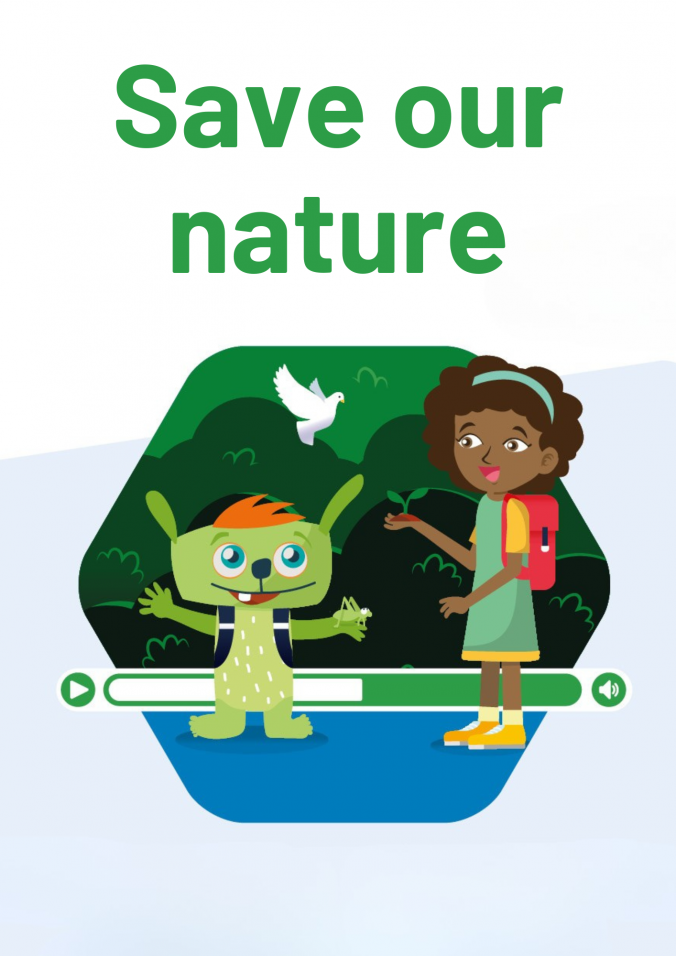How can we Identify Acids and Bases?

Overview
Overview
Keywords: acid, base, neutral, pH
Subjects: chemistry
Age group: 7-10 years old
Difficulty level: ● ● ○ (medium)
![]()
![]()
![]()
This experiment is part of the unit "Climate Action" written by: Esra Aksoy (TR), Rebecca Mudde (GB), Rute Oliveira (PT), Anastasia Papakonstantinou (GR)
The video "How can we identify acids and bases?" is an introduction to the concept of pH for young learners. The experiment utilises red cabbage as a natural pH indicator to distinguish between acidic, basic, and neutral substances commonly found at home.
This experiment should precede the two activities “How does Acid Rain Damage our Buildings?” and “How does Acid Rain Affect Plants?”.
Lilu is confronted with a challenge. He has three glasses filled with clear liquids, but the contents remain a mystery to him. The liquids in question include window cleaner, tap water, and vinegar or lemon juice. How can we help Lilu find out what the liquids are, in a safe manner?
The experiment focuses on the property of red cabbage as a natural pH indicator. When adding the solutions whose acidity we want to check to the red cabbage solution, it changes its colour. Thus, students can visually observe and classify substances based on the colour of the red cabbage solution.
By linking the experiment to the effects of acid rain, students will develop an early awareness of for environmental issues caused by human activities. Acid rain is not directly related to climate change, but is another result of burning fossil fuel.
Through hands-on experiments, students will acquire essential skills in conducting experiments, accurately recording observations – all of which are crucial for future scientific pursuits.
The experiment
Required materials
- water
- a red cabbage
- vinegar
- window cleaner
- baking soda
- a lemon
- toothpaste
- a kettle
- a jug
- transparent cups
Safety notes
The substances should be tested with caution.
Always check if the children have allergies to any of them and be extra careful when using cleaning solutions.
Do not test drain cleaner or any cleaning products containing bleach as undesirable chemical reactions can occur and these products are not safe for children to handle.
Experiment guide
This experiment can be performed by the teacher for the class, but depending on the materials available, age and autonomy level of the students, they can perform the experiment in small groups.
Preparing the indicator solution
The indicator solution can be prepared in advance by the teacher or, e.g., in a prior lesson.
- Start with boiling water in a kettle. This step should be performed by the teacher and proper precautions should be taken when using hot water to avoid burns.
- Place red cabbage leaves in a jar. If the cabbage is cut, the solution will be ready faster. Add the boiling water. The water will now take a purple colour.
- Allow the solution to cool down and strain it.
Using the indicator solution
- This purple solution can now be used to test different liquids such as: lemon juice, orange juice, toothpaste, window cleaner, vinegar, water, among others. If you want to test a solid substance (like soda, for example), you have to add it to water to obtain a liquid solution.
- All you have to do is to pour the indicator solution into transparent cups and then add the liquids or solutions to be tested.
- If the indicator maintains its colour, the tested liquid or solution is neutral, if it acquires a blue or green colour, it is basic, and if it turns pink, it is acidic.
Notes
Keep in mind that if the liquids or solutions to be tested are coloured, this may affect the final results.
The water used to prepare the solution may itself have a more acidic or basic pH, as not all tap water is neutral. This can affect the colour of the initial solution. Ideally, use distilled water or look for bottled water labelled with a pH close to 7.
Natural phenomena that occur around us are complex and difficult to replicate in the laboratory, therefore we use models. Models are simplifications of reality that allow us to understand what happens in the real world in a more accessible way.
Instead of boiling the water to prepare the indicator solution, you can also smash the red cabbage leaves to avoid using hot water with younger children.
To prepare the indicator, you need:
- a few red cabbage leaves
- deionized water or tap water
- a mortar
The kids can make the indicator on their own, but as it gets messy, wearing gloves and aprons is highly recommended.
For instructions for creating the indicator, watch the video:
Questions for students
Suggestions for questions that you could ask the students when the video stops.
- Why do you think it is important to know whether a substance is an acid, a base or neutral?
- Can you identify acidic substances in your everyday life? What about basic substances?
- Is the water we drink neutral?
The experiment with the result
Acids and bases have different properties. Acids are substances, some of which have a sour taste, like sour candies or lemon juice. Bases are the opposite of acids. Some of them have a bitter taste or feel slippery when you touch them, like soap. 1 Other things are not acids, nor bases. These are called neutral solutions. Water is a great example for a neutral solution. It doesn't taste sour or bitter, and it doesn't feel slippery.
But in chemistry we can't taste or touch solutions to distinguish whether they're sour or bitter, due to health and safety concerns, so we have to look for another way to find this information.
In order to test whether a substance is an acid or a base, you can dissolve it in water (if it is not already a liquid). Then you may use an acid-base indicator which changes its colour depending on whether the solution is an acid or a base. Red cabbage leaves contain a substance called anthocyanin that changes colour depending on whether they are mixed with an acid or a base. In the presence of an acid, it acquires a pink or red colour and in the presence of a base, it acquires a blue or green colour. In the presence of a neutral liquid or solution, it retains its purple colour.
The pH scale is a scale to determine how acidic or basic a substance is. The scale goes from 0 to 14, with below 7 being acidic and above 7 being basic. This scale is important in areas such as agriculture, as different species grow better in a soil with a certain pH. It is also important to measure the pH of products we use daily, like water, to ensure their quality.
How does this video link to sustainability?
In science lessons we can investigate the pH of different chemicals using a pH indicator. The pH of a substance tells us whether it is acidic, basic or neutral.
We can also discuss how pH levels affect the environment. For example, acidic or basic conditions in soil and water can impact plant and animal life. The students may come up with the concept of acid rain. Measuring the pH of rainwater can provide insights into environmental pollution. The students should understand that climate change is not the only environmental issue caused by human activities. Acid rain is not directly related to climate change, but has a similar cause: the burning of fossil fuels. pH measurements are very important in agriculture to determine the suitability of the soil for different crops.
Differentiated learning
Explore ideas how you can use this material in your class and adapt it to a group of various levels and learning styles.
Easier
- Use red cabbage to make strips of pH indicator paper. Simply soak sheets of paper in the red cabbage indicator solution, leave to dry and then use as indicator paper to test different liquids or solutions.
- Children with a greater aptitude for more artistic areas can create drawings and even organise an exhibition using their own hand-made watercolours and paper previously painted with red cabbage solution.
More challenging
- Challenge them to make predictions about the results before conducting the experiment. Ask them to explain why they think a particular substance will have a specific pH.
- Suggest that they propose additional experiments to resolve a problem, like: How can we neutralise an acidic substance?
Career orientation
Which career options are linked to this experiment and how can you introduce them to your students?
By exploring this experimental activity, children can be inspired to consider future careers in science. This could be a good opportunity to spark interest in professions that seek to understand and find solutions to climate change, such as an environmental laboratory technician.
Environmental laboratory technician
Environmental laboratory technicians conduct water quality testing, analyse hazardous waste, and prepare samples for testing. They also calibrate and operate lab equipment, document results, and perform quality control and assurance procedures.
Environmental science and protection technician video
What is an environmental laboratory technician?
Environmental laboratory technicians are scientists who work in a laboratory to analyse samples from the environment. They analyse various samples such as water, soil, and air samples to search for pollutants and contaminants. Environmental laboratory technicians use a variety of specialized equipment and techniques to detect harmful substances. Through their work, they ensure that our environment is safe for everyone.
What does a day in the life of an environmental laboratory technician look like?
Environmental laboratory technicians can work with different samples like air, water, or soil. They measure temperatures, mix substances, put labels on samples, use microscopes to see something that is very small, and other instruments to do analyses. During their day they can analyse data using specific computer programs and can meet with other technicians to share their findings.
What responsibilities do they have?
Environmental laboratory technicians may work for government agencies, environmental consulting firms, or private laboratories. It is their responsibility to perform analyses in accordance with certain standards to ensure that the results are reliable. Through this, they enable their institutions to act to protect the environment.
Further ideas
- Create art with your students and dye fabrics with your cabbage indicator! Download the "Ecoart with science" guide as docx or pdf.
- Using red cabbage juice, one can impart an unusual colour to desserts, baked goods, or sauces, and the colour can be further modified with the addition of lemon juice, particularly in sauces.
- An alternative indicator: Black tea. The tea lightens when acidic solutions are added and darkens when alkaline solutions are introduced.
- Create a story with solutions changing colour in a magic scientific way, like in the example “Magic acids and alkalines”.
Peter V. Hobbs, Acids and bases. Basic Physical Chemistry for the Atmospheric Sciences (2012).
(last accessed 19.12.2024)Rute Oliveira: Magic acids and alkalines
(last accessed 19.12.2024)Red Cabbage Indicator, American Chemical Society (ACS)
(last accessed 19.12.2024)Try out the experiment "Doughs with different colours" from Lilu's House - Kitchen Curiosities (page 17) to further explore the use of red cabbage as an indicator.
Teija Lauronen, Tiina Viberg, Tiina Leppämäki, Natural Colours In Fine Arts (2021).
(last accessed 19.12.2024)Booklet about how to use red cabbage, acids and bases to create pigments for painting, written by participants of the European Science on Stage festival 2022 (festival project “Manufacture of drawing charcoal”)
Career orientation video:
Environmental science and protection technician
(last accessed 9.12.2024)
This experiment is part of the unit "Climate Action" written by: Esra Aksoy (TR), Rebecca Mudde (GB), Rute Oliveira (PT), Anastasia Papakonstantinou (GR)
Share this page

